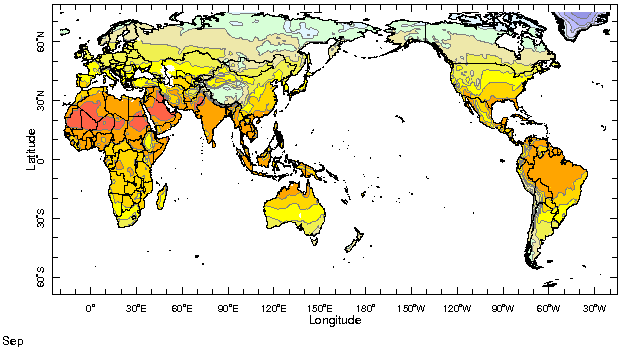|
IRI Climate Digest
October 2005
September Global Climate Summary
Climatological Background
During September, the Northern Hemisphere monsoon systems in West Africa, South Asia, and southwestern North America begin their retreat southward following the maximum solar heating, which approaches the equator at the time of the equinox (September 21). Spring has begun in the Southern Hemisphere, with mid-latitude storm tracks losing strength.
Monthly Mean Temperature (1961-1990), data from the Climate Research
Unit, University of East Anglia


Monthly Mean Precipitation (1961-1990), data from the Climate Research
Unit, University of East Anglia


Temperatures
Monthly mean surface temperatures were above average over most of the land areas of the globe during September. The largest positive departures, which exceed 3°C above normal, were found over central sections of North America, eastern Europe, central Asia, and north-central Russia. Temperatures were also above normal throughout most of Africa, in north-central Australia, and in northern South America. Below-normal temperatures were found along the west coast of the U.S., the Canadian Rocky Mountains, and from Boliva and northern Chile to northern Argentina and Uruguay.
Temperature Difference from the 1961-1990 mean, with data
from NCEP Climate Prediction Center, CAMS.


Precipitation
Much of southeastern Europe, which has been persistently wet throughout the boreal summer, received above-normal precipitation in September that resulted in damaging floods again in Romania and Bulgaria. September precipitation remained below normal elsewhere in eastern Europe and southern Scandinavia. With the approach of the end of the monsoon season, precipitation was above normal across much of the West African Sahel. After a relatively dry August, precipitation totals rebounded over the Indian subcontinent in September, marking the end of the southwest monsoon. Typhoons Talim, Khanun, and Longwang contributed to large rainfall totals in eastern China. In southeast Asia and the Indonesian archipelago, precipitation totals were well above normal throughout most of Thailand, in southern Sumatra, in western Java, and in much of New Guinea. Much of the western Pacific Ocean between 170°E and the eastern Philippines experienced above-normal precipitation as well. Although Hurricane Rita brought heavy rainfall to parts of the Mississippi River valley, precipitation was below normal along the east coast of the U.S. In South America, a swath of above-normal precipitation stretched from eastern Bolivia and Paraguay southeastward into southern Brazil and Uruguay.
Precipitation Difference from 1979-2000 mean, with data
from NCEP Climate Prediction Center, CAMS-OPI.


Oceanic Conditions
Tropical sea surface temperatures (SSTs) during September exhibited little change from those of the previous month. The primary exception was the cooling of sea surface conditions in the tropical Pacific near 100°W, where SST anomalies fell to 1°C below normal. SSTs in the tropical Atlantic Ocean remained higher than average, with anomalies as high as +1.5°C. Farther north in the mid-latitudes of the Atlantic Ocean, conditions remained well above average. Although temperatures decreased slightly compared to normal near 30°N, SSTs were largely 1-2°C above average across that region. Warmer-than-average conditions remained the dominant feature in the northern Pacific Ocean as well. In the mid-latitudes of the southern hemisphere, SSTs remained above average in the southeast Pacific and southeast Atlantic Oceans, and generally below average in the southern Indian Ocean.
Monthly Sea Surface Temperature Difference from the 1971-2000 mean,
with data from the Environmental Modeling Center, NCEP/NOAA.


Contents |
Special |
Impacts |
Climate |
Forecast
|

